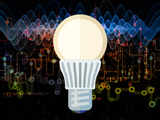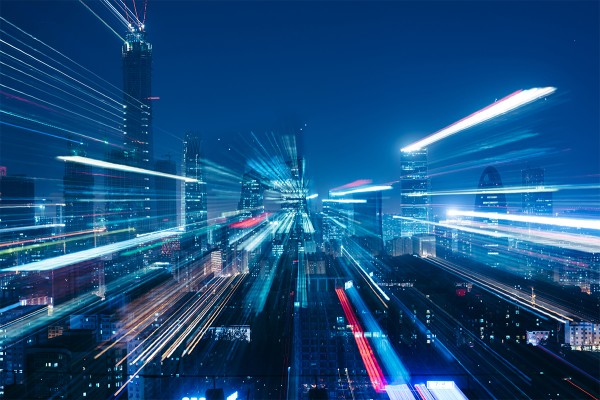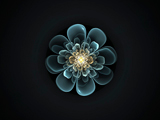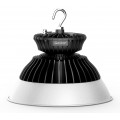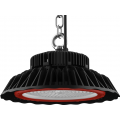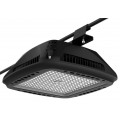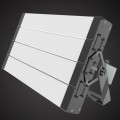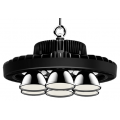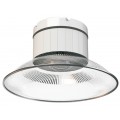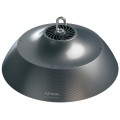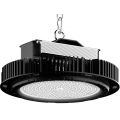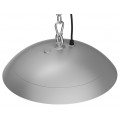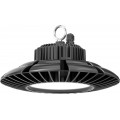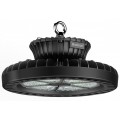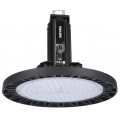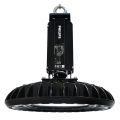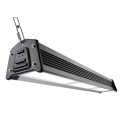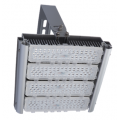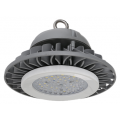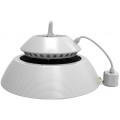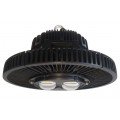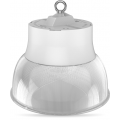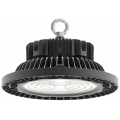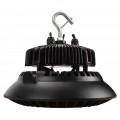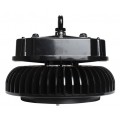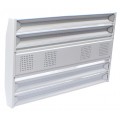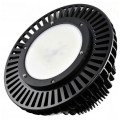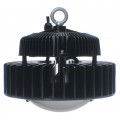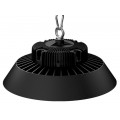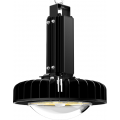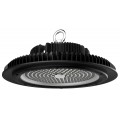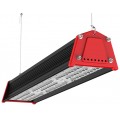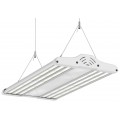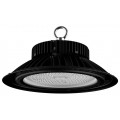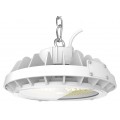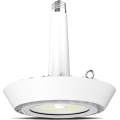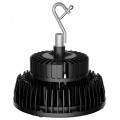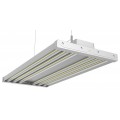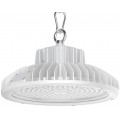Lighting is utilized to provide illumination when it's dark or to provide supplemental lighting for a dark area. In the lighting industry, one may have heard the terms "high bay" and "low bay" lighting, which generally describes the space and the height of the ceilings involved. There aren't any standard numerical value to characterize what constitute high bay or low bay. Often in large structures, overhead illumination is provided from luminaires mounted close to the ceiling of the building and the light is directed downward. Low bay fixtures are employed in the building where a ceiling height is between 15 and 25 feet, and high bay fixtures are used with ceiling heights of 20 to 40 feet. A high bay luminaire is a luminaire that may be constructed for industrial locations high above floor or work level. High bay luminaires have in the past found targeted use in warehouses, manufacturing facilities and gradually more in retail buildings wherein ceiling heights demand sufficient illumination of particular areas within an overall space. Low bay luminaries of very close configuration find usage in lighting applications having varying lighting requirements.
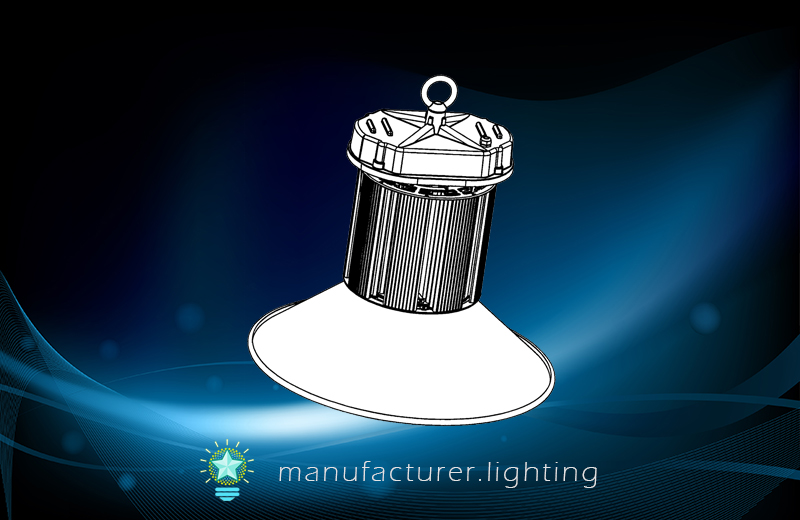
High bay lights are those light fixtures designed for application in buildings that have high ceilings, or "high bays" such as warehouses, manufacturing facilities, or the like where the ceilings can be 30-40 feet high. They are for applications with spacing-to-mounting height ratios of up to 1.0. They are surface or pendant mounted, based on the structure and openness of the area. These luminaires use reflectors and refractors to create luminous intensity distributions that differ from narrow to wide, subject to the application and the requirement for vertical illuminance. In cleaner industrial environments, high power linear and compact fluorescent lamps are installed in open high bay luminaires with specular reflectors for optical control. Other environments often necessitate an enclosed luminaire and the use of HID lamps with prismatic refractors for optical control. General illumination in industrial facilities is typified by high bay fixtures by making use of HID or high-output fluorescent sources, and target illuminances of 300 lux (30 fc) and greater. Nevertheless, these light fixtures are made of materials which may detrimentally affect the environment, such as mercury and heavy metals. Further more, HID lamps will possibly break or otherwise violently fail as a consequence of misapplication, system failure, or an assortment of additional circumstances. These failures can generate very hot glass and lamp parts resulting in a risk of fire, personal injury, or property damage.
Lamp manufacturers are almost always finding ways to increase the amount of foot candles of illumination which may be gained for a fixed amount of power consumption or wattage. Solid-state lighting (SSL) is a type of lighting that employs light-emitting diodes (LEDs) as sources of illumination instead of electrical filaments or gas. LEDs overcome a number of negative aspects of traditional lamps due to their notably longer lifetime, higher efficiency, and ability to direct the light. LED high bay lights are ideal for frequent switching applications. They are fully dimmable and offer multi-level illumination. These systems are capable of operating reliably in an array of ambient temperatures, with a good number of fixtures specially engineered to operate in rigorous environments such as hazardous locations. Modular ability allows LEDs to be removably mounted in fixtures whereby the LEDs can be easily manipulated, configured, and/or moved relative to each other or other components. Increased energy efficiency can contribute to significant energy savings associated with lighting devices, while the long lifetime can bring on low maintenance of hard to reach light fixtures, including high bay and low bay fixtures. LED lighting does not have a re-lamping cost, which can be a substantial expense in high-bay applications. LED-based high-bay luminaire not just simply offers energy efficiency benefits but its long lifetime also cuts down maintenance charges in typically hard-to-reach industrial and commercial applications.
Different from conventional omnidirectional incandescent, metal halide, sodium, or fluorescent lights, LEDs are directional in nature and need optics exclusively configured to optimize the spread of light over a given area to meet up with the light output patterns required for many applications. LED high bay light fixtures typically can be manufactured using a number of discrete LED chips that are bundled together to collectively create a desired output. Discrete LED chips are small enough therefore they are treated as a point source when designing the refractor and/or the reflector around each of the discrete LED chips. While the optical design is a lot easier when bundling discrete LED chips together to make conventional LED light fixtures, these conventional LED light fixtures are not so efficient, have a bigger manufacturing cost because of the number of LEDs and optics that are used, and come up with a tremendous amount of heat that is dissipated to the surrounding environment. Integrated LED arrays provide bright, uniform light output. These packages most often have a low thermal resistance which makes it possible for low junction temperatures at the chip level, and in so doing contributing to higher efficiencies. Fewer LEDs and optics are employed when using LED arrays than when using discrete LED chips, therefore lowering manufacturing costs. The objective of the reflector is often to reflect the light emitted upward back off toward the chosen illumination area. The LED high bay can be mounted at heights to a maximum of 12 meters with a standard beam angle of 120 degrees for a wide light distribution to illuminate large areas of factory or warehouse floors, which cuts down on the number of luminaires needed across the application. Aluminum or borosilicate glass reflectors can also be included to narrow the beam angle to 60, 70 or 90 degrees for a more targeted distribution in aisles or corridors. The high bay luminaire may additionally include a lens. The lens may be configured to interact with light radiated by the light source to refract, reflect, or otherwise redirect incident light. Aside from that, the lens may be formed of any material with transparent or translucent properties to accommodate the desired refraction to be accomplished by the lens.
The thermal solution is a primary factor in the success of high bay design, as the LEDs are concentrated in the center of the luminaire. Approximately 40% of that energy is transformed into radiant flux and the remaining to heat. High bay lighting products are often designed to work at a few hundred watts, up to about 400 watts. With that much power, a considerable amount of heat is generated, which should be dissipated. Methods for dissipating heat at these levels generally use extruded heat sinks and forced air blown over the extruded heat sinks. The heat sink serves dual functions in this high-bay design: for the most part to dissipate the thermal load of the LED, and additionally to provide a frame for the fixture. This provides for as much surface area as possible to be exposed to ambient conditions and takes full advantage of designing the luminaire surrounding the LED arrays. The heat sink may be constructed of any suitable material such as aluminum or other metal alloy possessing desirous thermal properties and configured to screen the elements of the high bay luminaire from environmental factors that could impede its function in addition to transfer heat generated from the LEDs. Additional features may be included to improve the thermal dissipation capacity of the luminaire.
As with other LED lamps, a reliable power supply (AC-DC power converter, or driver) play an important role in the lifespan of high bay luminaire. LED drivers are generally not as reliable as LED chips, and consequently can limit the operating lifetime of a LED light source.












